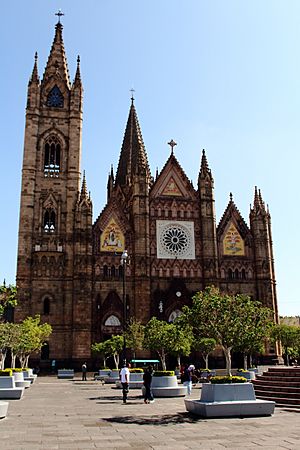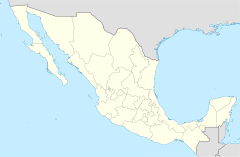Templo Expiatorio del Santísimo Sacramento facts for kids
Quick facts for kids Templo Expiatorio del Santísimo Sacramento |
|
|---|---|
 |
|
| Location | |
| Location | Guadalajara, Jalisco, Mexico |
The Templo Expiatorio del Santísimo Sacramento is a beautiful Catholic church in Guadalajara, Jalisco, Mexico. It's dedicated to the Blessed Sacrament, which is a special part of the Catholic faith. This church is built in a style called neo-Gothic, which means it looks like old European cathedrals from the Middle Ages. Many people think it's the best example of this style in Mexico! Building this amazing church took a very long time, starting on August 15, 1897, and finally finishing 75 years later in 1972.
Contents
Building a Dream: The Church's History
Starting the Grand Project
The idea for building a special church dedicated to the Blessed Sacrament in Guadalajara began in the late 1800s. A group of Catholic people formed a committee to make this dream come true. The city's archbishop, Pedro Loza y Pardavé, worked with this group. They held a competition for architects and engineers to design the new temple.
The first design was created by Engineer Salvador Collado Jasso. However, he sadly passed away from yellow fever, and the construction stopped. To continue the project, a famous Italian architect named Adamo Boari was chosen. He had been brought to Mexico by the country's president, Porfirio Díaz. Boari had also worked on other important buildings like the Palacio de Bellas Artes and the Palacio de Correos de Mexico in Mexico City.
Construction Begins and Pauses
The construction officially began with a special ceremony on August 15, 1897. Archbishop Pedro Loza y Pardavé and Pedro Romero led the event. By 1911, the large columns inside the church were already finished. Pedro Moreno and Feliciano Arías were in charge of the project. When Feliciano Arías died, his son Jerónimo Arías took over.
However, work on the temple had to stop during the Mexican Revolution. This was a difficult time for the country. There were problems with religious freedom, safety, and a big economic crisis.
Finishing the Masterpiece
In February 1924, Pedro Romero passed away. The priest José Garibi Rivera was then given the important task of finishing the temple. He quickly asked engineer Luis Ugarte to help him. The construction picked up speed again.
On January 6, 1927, the project was assigned to architect Ignacio Díaz Morales. He oversaw the work for many years until the church was finally completed in 1972.
Exploring the Church's Amazing Features
Beautiful Details and Art
The church's main doors are made from a special wood called granadilla. They were carved by Jesús Gómez Velazco. These doors also have beautiful bronze pictures, called high reliefs, made by master Benito Castañeda.
Above the doors on the church's front, there are three decorated spaces called tympana. These are filled with amazing Italian mosaics. These mosaics were made in the Vatican's Mosaic Factory! The mosaic in the middle shows the Paschal Lamb. The one on the east side shows Saint Tarcisius, and the one on the west shows St. Pius X. A painter and expert from the Vatican Museums, Francisco Bencivenga, designed these mosaics and made sure they were placed perfectly.
The Musical Clock Tower
The church has a special clock that was brought all the way from Germany. It has four lighted faces, so you can see the time easily. It also came with a carillon, which is like a giant musical instrument with 25 bells! These bells can play 25 different songs, including religious tunes and popular Mexican music. Some of the songs you might hear are Ave María, the Mexican National Anthem, Las Mañanitas, Guadalajara, Adiós Mariquita Linda, Las Golondrinas, México Lindo y Querido, and the March of Zacatecas. Someone can even play the chime from a keyboard inside the church choir!
The clock and bells were quite expensive, costing about 450 million pesos in 1972 (which would be about MXN$450,000 today). German technicians came to install them. There's a really cool detail on the bell tower: tiny statues of the 12 apostles rotate out of the tower whenever a song is played!
Stone, Glass, and Light
The church is built mostly from stone, which was carved by hand, just like buildings were made in the Middle Ages. The huge, colorful stained glass windows, including the big round window called a rosette on the front, were made in France by Jacques and Gerard Degusseau. They followed designs created by the artist Maurice Rocher from Paris. These windows fill the church with beautiful light and colors.
See also
 In Spanish: Templo Expiatorio del Santísimo Sacramento para niños
In Spanish: Templo Expiatorio del Santísimo Sacramento para niños




